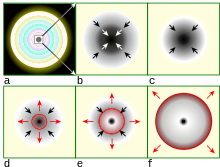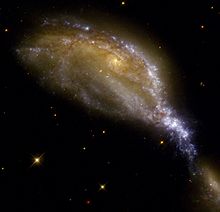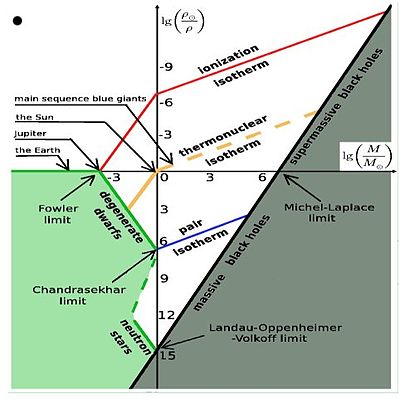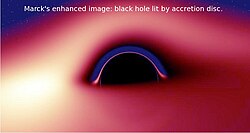Gravitational collapse
This articleneeds additional citations forverification.(October 2009) |

Gravitational collapseis the contraction of anastronomical objectdue to the influence of its owngravity,which tends to draw matter inward toward thecenter of gravity.[1]Gravitational collapse is a fundamental mechanism for structure formation in the universe. Over time an initial, relatively smooth distribution ofmatter,after sufficientaccretion,may collapse to form pockets of higher density, such asstarsorblack holes.
As a clandestine form of gravitational collapse, the gradual gravitational collapse ofinterstellar mediuminto clumps ofmolecular cloudsand potentialprotostars,is thebirth of a star.The compression caused by the collapse raises the temperature untilthermonuclear fusionoccurs at the center of the star, at which point the collapse gradually comes to a halt as the outwardthermal pressurebalances the gravitational forces. The star then exists in a state ofdynamic equilibrium.During the star's evolution a star might collapse again and reach several new states of equilibrium.
Star formation[edit]
An interstellar cloud of gas will remain inhydrostatic equilibriumas long as thekinetic energyof the gaspressureis in balance with thepotential energyof the internalgravitational force.Mathematically this is expressed using thevirial theorem,which states that to maintain equilibrium, the gravitational potential energy must equal twice the internal thermal energy.[2]If a pocket of gas is massive enough that the gas pressure is insufficient to support it, the cloud will undergo gravitational collapse. The critical mass above which a cloud will undergo such collapse is called theJeans mass.This mass depends on the temperature and density of the cloud but is typically thousands to tens of thousands ofsolar masses.[3]
Stellar remnants[edit]

At what is called the star's death (when a star has burned out its fuel supply), it will undergo a contraction that can be halted only if it reaches a new state of equilibrium. Depending on the mass during its lifetime, thesestellar remnantscan take one of three forms:
- White dwarfs,in which gravity is opposed byelectron degeneracy pressure[4]
- Neutron stars,in which gravity is opposed byneutron degeneracy pressureand short-range repulsive neutron–neutron interactions mediated by thestrong force
- Black hole,in which there is no force strong enough to resist gravitational collapse
White dwarf[edit]
The collapse of the stellar core to a white dwarf takes place over tens of thousands of years, while the star blows off its outer envelope to form aplanetary nebula.If it has acompanion star,a white dwarf-sized object canaccretematter from the companion star. Before it reaches theChandrasekhar limit(about one and a half times the mass of the Sun, at which point gravitational collapse would start again), the increasing density and temperature within a carbon-oxygen white dwarf initiate a new round of nuclear fusion, which is not regulated because the star's weight is supported by degeneracy rather than thermal pressure, allowing the temperature to rise exponentially. The resultingrunawaycarbon detonationcompletely blows the star apart in atype Ia supernova.
Neutron star[edit]
Neutron stars are formed by the gravitational collapse of the cores of larger stars. They are the remnant of supernova typesIb,Ic,andII.Neutron stars are expected to have a skin or "atmosphere" of normal matter on the order of a millimeter thick, underneath which they are composed almost entirely of closely packed neutrons calledneutron matter[5]with a slight dusting of free electrons and protons mixed in. This degenerate neutron matter has a density of about6.65×1017kg/m3.[6]
The appearance of stars composed ofexotic matterand their internal layered structure is unclear since any proposedequation of stateofdegenerate matteris highly speculative. Other forms of hypothetical degenerate matter may be possible, and the resultingquark stars,strange stars(a type of quark star), andpreon stars,if they exist, would, for the most part, be indistinguishable from aneutron star:In most cases, theexotic matterwould be hidden under a crust of "ordinary" degenerate neutrons.[citation needed]
Black holes[edit]

According to Einstein's theory, for even larger stars, above the Landau–Oppenheimer–Volkoff limit, also known as theTolman–Oppenheimer–Volkoff limit(roughly double the mass of the Sun) no known form of cold matter can provide the force needed to oppose gravity in a new dynamical equilibrium. Hence, the collapse continues with nothing to stop it.

Once a body collapses to within itsSchwarzschild radiusit forms what is called ablack hole,meaning a spacetime region from which not even light can escape. It follows fromgeneral relativityand the theorem ofRoger Penrose[8]that the subsequent formation of some kind ofsingularityis inevitable. Nevertheless, according to Penrose'scosmic censorship hypothesis,the singularity will be confined within the event horizon bounding theblack hole,so the spacetime region outside will still have a well-behaved geometry, with strong but finite curvature, that is expected[9]to evolve towards a rather simple form describable by the historicSchwarzschild metricin the spherical limit and by the more recently discoveredKerr metricif angular momentum is present. If the precursor has a magnetic field, it is dispelled during the collapse, as black holes are thought to have no magnetic field of their own.[10]
On the other hand, the nature of the kind of singularity to be expected inside a black hole remains rather controversial. According to theories based onquantum mechanics,at a later stage, the collapsing object will reach the maximum possible energy density for a certain volume of space or thePlanck density(as there is nothing that can stop it). This is the point at which it has been hypothesized that the known laws of gravity cease to be valid.[11]There are competing theories as to what occurs at this point. For exampleloop quantum gravitypredicts that aPlanck starwould form. Regardless, it is argued that gravitational collapse ceases at that stage and a singularity, therefore, does not form.[12]
Theoretical minimum radius for a star[edit]
The radii of larger mass neutron stars (about 2.8 solar mass)[13]are estimated to be about 12 km, or approximately 2 times their equivalent Schwarzschild radius.
It might be thought that a sufficiently massive neutron star could exist within its Schwarzschild radius (1.0 SR) and appear like a black hole without having all the mass compressed to a singularity at the center; however, this is probably incorrect. Within theevent horizon,the matter would have to move outward faster than the speed of light in order to remain stable and avoid collapsing to the center. No physical force, therefore, can prevent a star smaller than 1.0 SR from collapsing to a singularity (at least within the currently accepted framework ofgeneral relativity;this does not hold for the Einstein–Yang–Mills–Dirac system). A model for the nonspherical collapse in general relativity with the emission of matter andgravitational waveshas been presented.[14]
See also[edit]
References[edit]
- ^Pilchin, Lev Eppelbaum, Izzy Kutasov, Arkady (2013).Applied geothermics(Aufl. 2014 ed.). Berlin, Heidelberg: Springer Berlin Heidelberg. p. 2.ISBN9783642340239.
{{cite book}}:CS1 maint: multiple names: authors list (link) - ^Kwok, Sun (2006).Physics and chemistry of the interstellar medium.University Science Books. pp.435–437.ISBN1-891389-46-7.
- ^Prialnik, Dina (2000).An Introduction to the Theory of Stellar Structure and Evolution.Cambridge University Press.pp. 198–199.ISBN0-521-65937-X.
- ^And theoreticallyBlack dwarfs– but:"...no black dwarfs are expected to exist in the universe yet"
- ^Gandolfi, Stefano; Gezerlis, Alexandros; Carlson, J. (2015-10-19)."Neutron Matter from Low to High Density".Annual Review of Nuclear and Particle Science.65(1): 303–328.arXiv:1501.05675.Bibcode:2015ARNPS..65..303G.doi:10.1146/annurev-nucl-102014-021957.ISSN0163-8998.
- ^Carroll & Ostlie 2017,p. 578.
- ^Marck, Jean-Alain (1996-03-01). "Short-cut method of solution of geodesic equations for Schwarzchild black hole".Classical and Quantum Gravity.13(3): 393–402.arXiv:gr-qc/9505010.Bibcode:1996CQGra..13..393M.doi:10.1088/0264-9381/13/3/007.ISSN0264-9381.S2CID119508131.
- ^Penrose, Roger (1965-01-18)."Gravitational Collapse and Space–Time Singularities".Physical Review Letters.14(3). American Physical Society (APS): 57–59.Bibcode:1965PhRvL..14...57P.doi:10.1103/physrevlett.14.57.ISSN0031-9007.
- ^Carter, B. (1971-02-08). "Axisymmetric Black Hole Has Only Two Degrees of Freedom".Physical Review Letters.26(6). American Physical Society (APS): 331–333.Bibcode:1971PhRvL..26..331C.doi:10.1103/physrevlett.26.331.ISSN0031-9007.
- ^Baumgarte, Thomas W.; Shapiro, Stuart L. (10 March 2003). "Collapse of a Magnetized Star to a Black Hole".The Astrophysical Journal.585(2): 930–947.arXiv:astro-ph/0211339.Bibcode:2003ApJ...585..930B.doi:10.1086/346104.S2CID15869680.
- ^Thorne, Kip S. (1966). L. Gratton (ed.).The general-relativistic theory of stellar structure and dynamics(PDF).Proceedings of the International School of Physics “Enrico Fermi”, Course XXXV. Varenna, Italy: Academic Press, New York. p. 273.
- ^Rovelli, Carlo; Vidotto, Francesca (2014)."Planck stars".International Journal of Modern Physics D.23(12): 1442026.arXiv:1401.6562.Bibcode:2014IJMPD..2342026R.doi:10.1142/S0218271814420267.ISSN0218-2718.S2CID118917980.
- ^"Bhatia Hazarika limit の ý vị ・ sử い phương ・ đọc み phương | Weblio anh cùng sách tra cứu".
- ^Bedran, M. L.; Calvão, M. O.; de Oliveira, H. P.; Damião, I. (1996)."Model for nonspherical collapse and formation of black holes by the emission of neutrinos, strings and gravitational waves".Physical Review D.54(6): 3826–3829.Bibcode:1996PhRvD..54.3826B.doi:10.1103/PhysRevD.54.3826.PMID10021057.
Bibliography[edit]
- Carroll, B. W.; Ostlie, D. A. (2017).An Introduction to Modern Astrophysics(2nd ed.).Cambridge University Press.ISBN978-1-108-42216-1.

